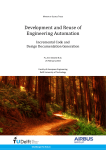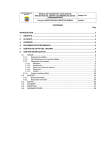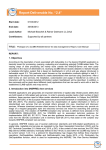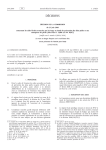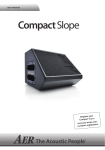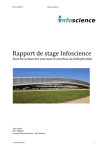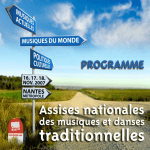Download Metadata Capture User Guide
Transcript
French Research Institute for Exploration of the Sea (Ifremer) Oceanography and Ecosystem Dynamics Department (ODE) Coastal Environment Dynamics Research Unit (DYNECO) Geomatics Applications Service (AG) Marie-Odile Lamirault-Gall October 2011 - R.INT.ODE/DYNECO/AG/2011-11/MOLG Metadata Capture User Guide For the Working Group on Marine Habitat Mapping (WGMHM) of the International Council for the Exploration of the Sea (ICES) GeoNetwork software, Version 2.6.3 Release 1.0 Metadata Capture User Guide For the Working Group on Marine Habitat Mapping (WGMHM) of the International Council for the Exploration of the Sea (ICES) GeoNetwork software, Version 2.6.3 Metadata Capture User Guide October 2011 Table of Contents 1. PREFACE 5 2. INTRODUCTION 7 3. ADDING NEW METADATA 9 3.1. CREATING A NEW RECORD 3.2. CLOSING THE EDITING SESSION 3.3. CREATING A THUMBNAIL 3.4. ASSIGNING THE PRIVILEGES AND MAP CATEGORY 4. IDENTIFICATION INFORMATION 4.1. TITLE* 4.2. ALTERNATE TITLE* 4.3. DATE* AND DATE TYPE* 4.4. PRESENTATION FORM 4.5. ABSTRACT* 4.6. PURPOSE 4.7. STATUS 4.8. POINT OF CONTACT 4.9. MAINTENANCE AND UPDATE FREQUENCY* 4.10. DESCRIPTIVE KEYWORDS 4.11. USE LIMITATION 4.12. ACCESS CONSTRAINTS AND USE CONSTRAINTS 4.13. OTHER CONSTRAINTS 4.14. SPATIAL REPRESENTATION TYPE 4.15. EQUIVALENT SCALE* 4.16. LANGUAGE* 4.17. CHARACTER SET 4.18. TOPIC CATEGORY CODE* 4.19. EXTENT 4.20. SUPPLEMENTAL INFORMATION 5. DISTRIBUTION INFORMATION 5.1. NAME* 5.2. VERSION* 5.3. TRANSFER OPTIONS 9 9 10 10 13 13 13 14 14 14 15 15 15 16 17 21 22 22 22 22 22 22 23 24 25 27 27 27 27 6. REFERENCE SYSTEM INFORMATION 6.1. CODE* 29 29 7. DATA QUALITY INFO 31 7.1. HIERARCHY LEVEL 7.2. STATEMENT 31 31 8. METADATA 33 8.1. METADATA LANGUAGE* 8.2. METADATA STANDARD NAME AND METADATA STANDARD VERSION 8.3. CONTACT* 33 33 33 9. EXECUTIVE SUMMARY 35 10. BIBLIOGRAPHY 37 Metadata Capture User Guide October 2011 5 1. Preface The Working Group on Marine Habitat Mapping (WGMHM) 2008 recognised that National Status Report information remains hidden within the WG reports rather than being widely available, e.g. via a web portal. It also recognised that the reports do not build, year by year, into a compiled catalogue of mapping studies. The proposed solution is to make the outlines of habitat mapping areas available online, linked to simple metadata. Following 2009 and 2010 WGMHM meeting recommendations, work has been done through a collaboration between the ICES data Centre and Ifremer to build a webGIS application showing the progress of habitat mapping throughout the ICES area. The habitat outline maps are now integrated in the ICES Spatial Facility (http://geo.ices.dk) as special layers with some additional functionality linking habitat map outlines with their metadata description. The ICES Spatial Facility host a collection of reference maps and other maps from the ICES community, that can be displayed in combination with the habitat maps. The ICES Spatial Facility is based on: o GeoServer (http://geoserver.org/display/GEOS/Welcome) – Open source software for sharing of spatial data (features WMS/WFS/WCS) o GeoNetwork (http://geonetwork-opensource.org/) Open source software for metadata handling The ICES Spatial Facility integrates the functionalities of GeoServer and GeoNetwork and creates the important linkage between the spatial datasets and their metadata. Following 2011 WGMHM comments on the explanation of the metadata fields, this document provides guidelines to use the GeoNetwork opensource software. This guide is based on the following document: GeoNetwork User Manual, Release 2.6.4 by the GeoNetwork Opensource Developers, 2011, http://geonetwork-opensource.org/manuals/2.6.4/users/GeoNetworkUserManual.pdf Metadata Capture User Guide October 2011 7 2. Introduction The metadata profile used by GeoNetwork opensource to describe geographic data stored in the ICES catalogue is based on the International standard ISO 19115:2003, encoded according to the implementation scheme 19139:2007. GeoNetwork provides a set of simplified metadata templates based on the standards ISO19115/19119. You can switch to another view of the template at any time while editing. • The most important fields are presented and described in the Default view. • The entire metadata profile is presented in an advanced view. The visualization and edition of the entire metadata structure is organised by package (12 sections) or by ISO group (ISO minimum, ISO Core, ISO all). • The XML view shows the entire content of the metadata in the original hierarchical structure, which is made up of tags and closing tags. It requires knowledge of XML language. The Default view shows a template called “Template for WGMHM (ISO 19115:2003/19139)”: • It is highly recommended to use this template, which shows the main fields from different categories of information in a single view. The template is similar to the default view for vector data in GeoNetwork, but some modifications have been added. • However, if you need to add more metadata elements, you can switch to the advanced view by package or by ISO group at any time while editing. Using basic commands of the editor: • Some fields are mandatory. They are flagged with a red asterisk *. • You can add multiple fields by clicking on the symbol next to the element. You can also delete existing fields by clicking on the symbol. • You can change the field order of the same kind by clicking on the symbol next to the element. • The symbol allows the opening, for the fields Descriptive keywords and Reference system information, of a thesaurus. • Some fields are free text fields. Therefore, you can enter text in the field. Some fields are drop down lists. You must select only one option from the list. Some fields are pre-filled with a default value which can be modifiable or not. • A standard definition for each field can be read by a left-click with the mouse on the element name. This manual is intended for practical use, therefore the fields are presented in the order they appear in the default view. Metadata Capture User Guide October 2011 9 3. Adding new metadata 3.1. Creating a new record Administrators wishing to load new metadata should connect to the GeoNetwork interface where they can manage all their metadata: http://geo.ices.dk/geonetwork/srv/en/main.home Beforehand, they must register with the overall administrator of the system, Hans Mose Jensen ([email protected]). In the home page, in top left menu, click on the Administration tab and then select New metadata from the list on the admin page. Figure 3.1: Administration panel From the Metadata creation page, select the "Template for the WGMHM (ISO19115:2003/19139)" and “WGMHM” from the drop-down menus and click on Create. Figure 3.2: Template and Group selection 3.2. Closing the editing session Figure 3.3: Row buttons in editing session After creating a new metadata, you could validate the current metadata record against standard rules and recommendations by clicking on "Check". The validation report displays the list of rules checked and their status. Metadata Capture User Guide October 2011 10 – Adding new metadata If you wish to continue creating your metadata at a later time, you can click on "Save" or "Save and close". 3.3. Creating a thumbnail To complete the metadata you can also insert a thumbnail image of the data. From the editing menu, click on the "Other actions" button and then select Thumbnails. Figure 3.4: the thumbnail management panel Using the Large thumbnail option allows you to create both a small and large thumbnail in one go. A large thumbnail allows users to properly evaluate the data usefulness. It will be a significant reproduction of the real dataset, possibly inclusive of the legend. You can use GIF, PNG and JPEG images as inputs for the thumbnails. A pop-up window will appear allowing you to browse your files on your computer. Select the file you wish to create a thumbnail with by double-clicking on it. Then click on "Add" and on "Back to editing". Your thumbnail will be added and displayed on the editing page. 3.4. Assigning the privileges and map category Finally you have to set the privileges and category to your metadata. On top of each individual record, you will always see a row of buttons including an "Other actions" button. Click on it and select "Privileges" then "Categories". Figure 3.5: "Other actions" button of individual record In the privileges action, you can choose all rights for your group (WGMHM). Metadata Capture User Guide October 2011 Adding new metadata – 11 Figure 3.6: Privileges settings A brief description for privileges already selected: Publish: users in the specified group(s) are able to see the map, i.e. if searching with matching criteria; Download: users in the specified group(s) are able to download the map; Interactive map: users in the specified group(s) are able to get an interactive map; Featured: when selected, the map is placed in the features maps on the home page; Notify: users in the WGMHM group receive notification that the map has been uploaded. Figure 3.7: Category setting In order to facilitate searching for specific habitat maps, each metadata description should be categorized in one of the three categories created in GeoNetwork for WGMHM habitat maps: "Modelled habitat metadata", "Substrate metadata" and " Surveyed habitat metadata". The other categories (presently only "Maps") are being used for background maps, i.e. ICES statistical areas, OSPAR regions or a review for each category above. As the ICES Spatial Facility is used by the entire ICES community other map types are expected to be added to the collection. Metadata Capture User Guide October 2011 13 4. Identification information This section contains information specific to the data (name, creation date, geographical area, etc ....). It remains within the strict framework of the information on the data. Figure 4.1: Default view - Identification info (1) 4.1. Title* The title of the resource is the name by which it is formally known. It must be sufficiently precise to describe the data content. The title may include a few words about the map contents, year of publication, scale and type of layer. It can remain in the language of origin. Examples: o Carte des peuplements macrobenthiques de la Baie de Seine et de la Manche centrale sud (1976), au 1/117000 sous forme de polygones o Chichester Harbour intertidal vegetation survey 2005 4.2. Alternate title* Each alternative title MUST ABSOLUTELY correspond to a record in the Data Exchange Format (DEF). The alternate title of the dataset is in the form of a two letter country code (which correspond to ISO 3166-1) plus six digits. Examples: o GBxxxxxx for United Kingdom, o IExxxxxx for Ireland o DKxxxxxx for Denmark Metadata Capture User Guide October 2011 14 – Identification information 4.3. Date* and Date type* These fields are used to indicate one or more representative dates in the life of the data (creation, publication, revision). It must include at least one date. Figure 4.2: Identification info - Date and Date type When the date is incomplete, it is shown "01" for the day and January for the month. The Date type can specify what kind of event matches the date entered. These dates are the dates of digital documents: o date of creation of digital data, o the date of publication (or distribution of the data or scientific publication) o the review date (or update or version) of the digital data. 4.4. Presentation form This field specifies the type of presentation of the data. Default: Digital map. You can change it by using the drop down list. 4.5. Abstract* This field includes a brief and significant summary of the content of the resource: • a short description of the geographical extent, • a summarized origin of the document, • short description, for example, of the type of data, study method (techniques, year(s) of the study …), mapping methodology, digitizing methodology, scale of use… Examples: o Carte des peuplements macrobenthiques de la Baie de Seine et de la Manche centrale sud (1976), au 1/117000 sous forme de polygones This map of the macrobenthic communities of the Seine Bay and south-central English Channel is reproduced from the map (scale = 1:117000) by Franck Gentil and Louis Cabioch from the Roscoff Oceanological Observatory, entitled "Carte des peuplements macrobenthiques de la Baie de Seine et de la Manche centrale sud" (Map of the macrobenthic communities of the Seine Bay and south-central English Channel) published in 1997. The documents, at the origin of this data set, Metadata Capture User Guide October 2011 Identification information – 15 are the result of research works made on the macrobenthic communities of the Seine Bay, as part of a systematic survey of the English Channel benthos. To realise this survey, 436 samples were collected between 1971 and 1976 on board the Pluteus II, a CNRS oceanographic vessel run by the Roscoff Biological Station (CNRS = Centre National de la Recherche Scientifique / French National Centre for Scientific Research). This map was digitized in 2003, as part of the REBENT programme, i.e. the surveying network for the benthic fauna and flora. The original legend is transferred to the "ORIG_HAB" attribute data field. The harmonization with the EUNIS typology is in progress, as part of the REBENT and Interreg-MESH programmes. o Habitat suitability map for mussel beds in Dutch Wadden Sea The dataset represents the habitat suitability for mussel beds in the Dutch Wadden Sea. The dataset is the result of a model (Multifactorial GLM). Eight underlying datasets such as depth, orbital velocity, current velocity, sediment composition, mussel beds area's, etcetera have been combined to create a habitat suitability index (in percentage) for mussel beds . 4.6. Purpose Purpose for which the study was conducted Examples: o Nature conservation, Research … 4.7. Status Status of the data within the drop down list Figure 4.3: Identification info - Status 4.8. Point of contact This section specifies the person(s) or the organization(s) to contact for additional information. You must fill in at least the Organisation name, the Role and the Electronic mail address. Metadata Capture User Guide October 2011 16 – Identification information Figure 4.4: Default view - Identification info (2) - Point of contact The organisation name: identification of the responsible organisation associated with the data. This field is mandatory if Individual name is not entered. The role*: this element defines the role of the responsible organisation in relation to the data. Choose an item in the drop down list. Tableau 4.1: Identification info - Point of contact - drop down list and definition Role Definition Author Party who authored the resource Custodian Party that accepts accountability and responsibility for the data and ensures appropriate care and maintenance of the resource Distributor Party who distributes the resource Originator Party who created the resource Owner Party who owns the resource Point of contact Party who can be contacted for acquiring knowledge about or acquisition of the resource Principal investigator Key party responsible for gathering information and conducting research Processor Party who has processed the data in a manner such that the resource has been modified Publisher Party who published the resource Resource provider Party who supplies the resource User Party who uses the resource The Electronic mail address*: an email address group can be specified. 4.9. Maintenance and update frequency* Figure 4.5: Default view - Identification info (3) Metadata Capture User Guide October 2011 Identification information – 17 This section specifies the frequency of scheduled update of the data, according to a closed list of possibilities. If any changes are scheduled, select "Not planned" in the dropdown list. If the frequency for the scheduled update is not available in the list, use the code "Unknown", and specify the frequency in free text either in the <Maintenance note> or in the <User defined maintenance frequency>. Tableau 4.2: Identification info - Maintenance - drop down list and definition Maintenance Definition Annually Data is updated every year As needed Data is updated as deemed necessary Biannually Data is updated twice each year Continual Data is repeatedly and frequently updated Daily Data is updated each day Fortnightly Data is updated every two weeks Irregular Data is updated in intervals that are uneven in duration Monthly Data is updated each month Not planned There are no plans to update the data Quarterly Data is updated every three months Unknown Frequency of maintenance for the data is not known Weekly Data is updated on a weekly basis 4.10. Descriptive keywords Keywords can help searching. Enter keywords that describe your map. Each keyword must be specified by a type. The type gives you a choice of five categories which allow you to specify whether the keyword relates to discipline (Discipline), places (location), geological strata (stratum), periods (time), and themes (theme). If there is any doubt about the type of keyword, it falls under the “Theme” category. It is best to enter each keyword in a new field depending on the type of keyword. Figure 4.6: Identification info - Several descriptive keywords Metadata Capture User Guide October 2011 18 – Identification information Default theme keywords: Marine habitat mapping Habitats and biotopes, from GEMET – INSPIRE themes thesaurus Figure 4.7: Default view - Identification info (4) - Descriptive keywords You can modify these keywords or add new ones. For example, if you want to change the keyword "habitats and biotopes" from the GEMET – INSPIRE themes thesaurus, click on the symbol next to the element. Then chose the "Inspire_themes.rdf" thesaurus and select the keyword(s) which correspond to your thematic. Figure 4.8: Identification info - Descriptive keywords - Keywords selection Tableau 4.3: GEMET - INSPIRE themes thesaurus INSPIRE theme Definition Addresses Location of properties based on address identifiers, usually by road name, house number, postal code. Administrative units Units of administration, dividing areas where Member States have and/or exercise jurisdictional rights, for local, regional and national governance, separated by Metadata Capture User Guide October 2011 Identification information – 19 INSPIRE theme Definition administrative boundaries Agricultural and aquaculture facilities Farming equipment and production facilities Area management/restriction/regulation zones and reporting units Areas managed, regulated or used for reporting at international, European, national, regional and local levels. Includes regulated fairways at sea or large inland waters, areas for the dumping of waste, prospecting and mining permit areas, coastal zone management areas … Atmospheric conditions Physical conditions in the atmosphere Bio-geographical regions Areas of relatively homogeneous conditions with common characteristics Buildings Geographical location of buildings Cadastral parcels Areas defined by cadastral registers or equivalent Coordinate reference systems Systems for uniquely referencing spatial information in space as a set of coordinates (x, y, z) and latitude and longitude and height, based on a geodetic horizontal and vertical datum Elevation Digital elevation for land, ice and ocean surfaces. Includes terrestrial elevation, bathymetry and shoreline Energy resources Energy resources including hydrocarbons, hydropower, bio-energy, solar, wind … where relevant including depth/height information on the extent of the resource Environment monitoring facilities Location and operation of environmental facilities includes observation and measurement of emissions, of the state of environmental media and of other ecosystem parameters by or on behalf of public authorities Geographical grid systems Harmonised multi-resolution grid with a common point of origin and standardised location and size of grids cells. Geographical names Names of areas, regions, localities, cities, suburbs, towns or settlements, or any geographical or topographical feature of public or historical interest Geology Geology characterised according to composition and structure. Include bedrock, aquifers and geomorphology Metadata Capture User Guide ecological October 2011 20 – Identification information INSPIRE theme Definition Habitats and biotopes Geographical areas characterised by specific ecological conditions, processes, structure, and (life support) functions that physically support the organisms that live there Human health and safety Geographical distribution of dominance of pathologies, information indicating the effect on health or well-being of humans linked directly or indirectly to the quality of the environment Hydrography Hydrographic elements, including marine areas and all other water bodies and items related to them, including river basins and sub-basins Land cover Physical and biological cover of the earth's surface including artificial surfaces, agricultural areas, forests, (semi-)natural areas, wetlands, water bodies Land use Territory characterised according to its current and future planned functional dimension or socioeconomic purpose (e.g. residential, industrial, commercial, agricultural, forestry, recreational) Meteorological geographical features Weather conditions and their measurements Mineral resources Mineral resources including metal ores, industrial minerals … where relevant including depth/height information on the extent of the resource Natural risk zones Vulnerable areas characterised according to natural hazards, e.g. floods, landslides and subsidence, earthquakes … Oceanographic geographical features Physical conditions of oceans (currents, salinity, wave heights…) Orthoimagery Geo-referenced image data of the Earth's surface, from either satellite or airborne sensors Population distribution – demography Geographical distribution of people, including population characteristics and activity levels, aggregated by grid, region, administrative unit or other analytical unit Production and industrial facilities Industrial production sites, including installations concerning integrated pollution prevention and control and water abstraction facilities, mining, storage sites Protected sites Area designed or managed within a framework of international, Community and Member States' Metadata Capture User Guide October 2011 Identification information – 21 INSPIRE theme Definition legislation to achieve specific conservation objectives Sea regions Physical conditions of seas and saline water bodies divided into regions and sub-regions with common characteristics Soil Soils and subsoil characterised according to depth, texture, structure and content of particles and organic material, stoniness, erosion, where appropriate mean slope and anticipated water storage capacity Species distribution Geographical distribution of occurrence of animal and plant species aggregated by grid, region, administrative unit or other analytical unit Statistical units Units for dissemination information Transport networks Road, rail, air and water transport networks and related infrastructure. Include links between different networks Utility and governmental services Includes utility facilities such as sewage, waste management, energy supply and water supply, administrative and social governmental services as public administrations, civil protection sites, schools and hospitals or use of statistical 4.11. Use limitation Figure 4.9: Default view - Identification info (5) This section corresponds to the legal restrictions on use. This allows with free text to indicate the restrictions under which the data must be used and what to do in other cases. Examples: o These files are intended for personal use. Any commercial use of these data is strictly prohibited. For any use other than personal, please contact the digital data custodian. Metadata Capture User Guide October 2011 22 – Identification information o Any modification of these data is subject to preliminary authorization. Please contact the person in charge of REBENT project. o Data is available under the terms of the ICES Data Policy. (See: http://geo.ices.dk/ices_dp.html) 4.12. Access constraints and Use constraints Selecting options from the drop down list, enter the constraints ensuring the protection of privacy or intellectual property, and any restrictions, limitations or warnings to obtain the data. If none of the values from the defined list are appropriate, then specify "Other restrictions" and complete the field <Other constraints> (cf. § 4.13), which is free text. 4.13. Other constraints This field becomes mandatory if Access constraints and Use constraints are not entered. This element shall provide information by free text on: • Any fees necessary to access and use the data, if applicable, or refer to a uniform resource locator (URL) where information on fees is available. • Quote obligations on resumption of digital data made available. Example: o Reference citation is required in the bibliography. 4.14. Spatial representation type Indicate whether the data is vector, raster, tabular, triangular mesh, 3D ... The field is filled automatically according to the model chosen for entering metadata (vector or raster). 4.15. Equivalent scale* An equivalent scale is generally expressed as an integer value expressing the scale denominator. 4.16. Language* The language(s) used within the data. Default: English. 4.17. Character set Character code used for the data set. Default: Utf8. Do not modify. Metadata Capture User Guide October 2011 Identification information – 23 4.18. Topic category code* The topic category is a high-level classification scheme to assist in the grouping and the search of available spatial data resources. Select the main ISO category or categories through which your map could be classified: Tableau 4.4: Identification info - ISO topic categories Topic categories Definitions Biota Flora and/or fauna in natural environment Boundaries Legal land descriptions Climatology, atmosphere meteorology, Processes and phenomena of the atmosphere Economy Economic activities, conditions and employment Elevation Height above or below sea level Environment Environmental resources, protection and conservation Farming Rearing of animals and/or cultivation of plants Geoscientific information Information pertaining to earth sciences Health Health, health services, human ecology, and safety Imagery base maps earth cover Base maps Inland waters Inland water characteristics Intelligence military Military bases, structures, activities Location Positional information and services Oceans Features and characteristics of salt water bodies (excluding inland waters) Planning cadastre Information used for appropriate actions for future use of the land Society Characteristics of society and cultures Structure Man-mad constructions Transportation Means and aids for conveying persons and/or goods Utilities communication Energy, water and waste systems and communications infrastructure and services features, Metadata Capture User Guide drainage systems and their October 2011 24 – Identification information 4.19. Extent Figure 4.10: Default view - Identification info (6) 4.19.1. Temporal extent It defines the time period covered by the content of the data. It is expressed by an interval of dates expressed through the beginning date and the end date of the interval. 4.19.2. Geographic bounding box This is the extent of the resource in geographic space, given as a bounding box. There are three different ways to fill this field: • Enter the westbound and eastbound longitudes and southbound and northbound latitudes, with a precision of at least two decimals. GeoNetwork automatically fills in the coordinates to the fifth decimal place. • Select a country, a region, an ocean or a sea from the drop down list. • Draw a rectangle on the map. Check that westbound < eastbound and southbound < northbound. Metadata Capture User Guide October 2011 Identification information – 25 4.19.3. Extent It defines the depth range surveyed by the content of the data. You have to indicate the height of the lowest and highest points of the data set. Don't forget to mention the retained unit. 4.20. Supplemental information Enter useful information that does not fit elsewhere in the metadata. For example: • Information about the attribute table of the layer. • Information about the classification system or typology. Metadata Capture User Guide October 2011 27 5. Distribution information This section provides information about options for accessing the data or obtaining other on-line resources related to the data through the web. Figure 5.1: Default view - Distribution information 5.1. Name* Name of the data transfer format. Examples: o Shapefile o TIFF 5.2. Version* Version of the format (date, number …). Example: o ESRI ArcGIS 9.3 5.3. Transfer options This section is used to specify the technical details for access to the online data (download, WMS ...). Metadata Capture User Guide October 2011 28 – Distribution information 5.3.1. OnLine resource You can create multiple instances of web addresses to indicate via which one the dataset can be acquired, and various documents referring to the dataset. Each information should include a link, a protocol and a description of the resource. URL: It shows the exact web address for direct access to the data (without using the home pages of the site). Protocol: It indicates the link type described in the drop down list; Web address (URL) is the only protocol to use. Description: Detailed description of the online source. Indicate clearly here the title of the links, as it is this text which appears in the metadata record. Metadata Capture User Guide October 2011 29 6. Reference system information This section contains information about the spatial reference system of the data. Figure 6.1: Default view - Reference system information 6.1. Code* This field provides an alphanumeric value identifying the reference system used. GeoNetwork open source uses the EPSG codes which are numeric codes associated with the coordinate system definition. Default value: WGS 1984 and added to the This code can be modified. It must be sought via the symbol metadata record. Thus the code and the name of the system are clearly shown and standardized. Using elements from the advanced view, you may add more details on data projection, ellipsoid and datum. Metadata Capture User Guide October 2011 31 7. Data quality info This section provides a general assessment of the quality of the data. Study of the data quality is not intended to say whether the data are good or bad but simply to verify that the suggested quality level fits in with the planned application and user requirements. Figure 7.1: Default view - Data quality info 7.1. Hierarchy level It describes the hierarchal level of data quality. Choose the element in the drop down list. The items most widely used are the “Data” set for spatial datasets and “Series” for spatial dataset series. 7.2. Statement This element becomes mandatory if the hierarchal level element is equal to Dataset or Series. This free text gives a general explanation of the production processes used for creating the data. It outlines the history of data describing the main stages of production and qualification of the data, indicating data that enabled the manufacturing, the different steps of production, monitoring and correcting phases... Metadata Capture User Guide October 2011 33 8. Metadata This section provides information about the metadata itself and the metadata author. Figure 8.1: Default view - Metadata 8.1. Metadata language* The language used within the metadata. Default: English. 8.2. Metadata standard name and Metadata standard version Standard chosen when creating the metadata sheet. Do not modify. 8.3. Contact* This section provides information about the author(s) or the organisation(s) responsible for the metadata record. You must fill in at least the Organisation name, the Role and the Electronic mail address. The organisation name: identification of the responsible organisation associated with the metadata. This field is mandatory if Individual name is not entered. The role*: this element defines the role of the responsible organisation associated with the metadata. Choose an item in the drop down list. The Electronic mail address*: an email address group can be specified. Metadata Capture User Guide October 2011 35 9. Executive summary The main mandatory fields that may not be waived are the following: Section Identification info Fields Title Alternate title Date and Date type Abstract Maintenance and update frequency Equivalent scale (Denominator) Language (used for documenting data) Topic category code Distribution information Name Version Reference system information Code Metadata Language (used for documenting metadata) Metadata author Some optional but critical fields which should be filled in: Section Identification info Fields Presentation form Purpose Status Point of contact: Organisation name, Role, Electronic mail address Descriptive keywords Use limitation Access and Use constraints Other constraints Spatial representation type Extent: Temporal extent, Geographic bounding box, Extent (i.e. Vertical extent) Metadata Capture User Guide October 2011 36 – Executive summary Section Distribution information Fields Transfer options: URL, Protocol, Description Data quality information Hierarchy level Statement Metadata Capture User Guide October 2011 37 10. Bibliography European Environment Information and Observation Network (EIONET), 2004, GEMET, the GEneral Multilingual Environmental Thesaurus, version 2004, http://www.eionet.europa.eu/gemet/groups?langcode=fr GeoNetwork Opensource Developers, 2011, GeoNetwork User Manual, Release 2.6.4. http://geonetwork-opensource.org/manuals/2.6.4/users/GeoNetworkUserManual.pdf ICES, 2008, Report of the Working Group on Marine Habitat Mapping (WGMHM), 31 March-4 April 2008, Horta, the Azores. CM 2008/MHC:08 Ref. FTC, ACOM.. 132 pp. http://www.ices.dk/reports/SSGSUE/2008/wgmhm08.pdf ICES, 2009, Report of the Working Group on Marine Habitat Mapping (WGMHM), 21-24 April 2009, The National Institute of Aquatic Resources, Charlottenlund Castle, Copenhagen, Denmark. ICES CM 2009/MHC:07. 78 pp. http://www.ices.dk/reports/SSGSUE/2009/WGMHM09.pdf ICES, 2010, Report of the Working Group on Marine Habitat Mapping (WGMHM), 3-7 May 2010, Calvi, Corsica, France. ICES CM 2010/SSGSUE:01. 86 pp. http://www.ices.dk/reports/SSGSUE/2010/wgmhm10.pdf ICES, 2011, Report of the Working Group on Marine Habitat Mapping (WGMHM), 10-13 May 2011, Calvi, France. ICES CM 2011/SSGSUE:05. 88 pp. http://www.ices.dk/reports/SSGSUE/2011/WGMHM11.pdf INSPIRE Metadata Implementing Rules: Technical Guidelines based on EN ISO 19115 and EN ISO 19119, V. 1.2, 2010-06-16, http://inspire.jrc.ec.europa.eu/documents/Metadata/INSPIRE_MD_IR_and_ISO_ v1_2_20100616.pdf Metadata Capture User Guide October 2011 38 – Bibliography INSPIRE, Drafting Team "Data Specifications" Definition of Annex Themes and Scope, 2008-03-18, http://inspire.jrc.ec.europa.eu/reports/ImplementingRules/DataSpecifications/D2.3 _Definition_of_Annex_Themes_and_scope_v3.0.pdf ISO 3166-1, Codes for the representation of names of countries and their subdivisions http://www.iso.org/iso/country_codes/iso_3166_code_lists.htm ISO 19115:2003(E), Geographic information – Metadata http://www.iso.org/iso/home.htm Lamirault-Gall Marie-Odile, Rollet Claire, Satra-Le Bris Catherine, Bermell Sylvain, Laffay Etienne, Lecuy Fanny, Quimbert Erwann, Pitel-Roudaut Mathilde, 2010, Sextant : Guide de saisie des métadonnées selon les normes et standards d'interopérabilité ISO 19115 et ISO 19139, dans l'interface GeoNetwork (version 2.0.1 personnalisée Ifremer)-Version 1.0. http://archimer.ifremer.fr/doc/00025/13671/ Lamirault-Gall Marie-Odile, Rollet Claire, Satra-Le Bris Catherine, Bermell Sylvain, Laffay Etienne, Lecuy Fanny, Quimbert Erwann, Pitel-Roudaut Mathilde, 2011, Sextant : Guide de saisie des métadonnées selon les normes et standards d'interopérabilité ISO 19115 et ISO 19139 et en conformité avec la directive INSPIRE, Version 3 de Sextant - interface GeoNetwork (version 2.0.1 personnalisée Ifremer)-Version 1.1. https://www.ifremer.fr/sextant_doc/sextant/20110204_Sextant_GuideSaisie_V1.1_Final.pdf Metadata Capture User Guide October 2011






































